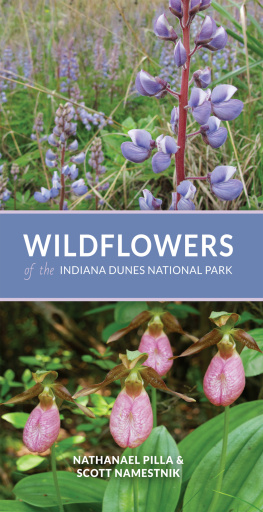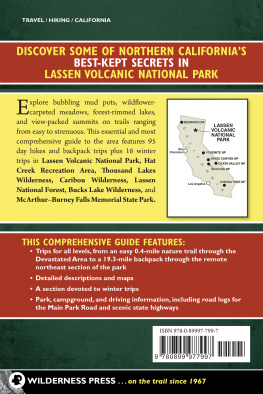Contents
Guide
There are many people who have made the writing and publication of this book possible, either through direct assistance or indirectly through their guidance, instruction, encouragement, and support over the years. We apologize to any of those weve inadvertently failed to acknowledge.
First, we dedicate this book to Keith Board and David Hamilla, two dunes region botanists with huge and lasting impacts on us and the region as a whole, who both left us too soon.
We graciously thank those who have come before us in the study of the plants of the Indiana Dunes region. Keith Board, Marlin Bowles, Henry Chandler Cowles, Charles Deam, Ken Dritz, David Hamilla, Peter Hebert, E. J. Hill, Lois Howes, Ken Klick, Marcus Lyon, Dan Mason, Dan McDowell, Myrna Newgent, Julius Nieuwland, Sandy OBrien, Noel Pavlovic, Donald Peattie, Herman Pepoon, Emma Pitcher, Barbara Plampin, Laura Rericha, Floyd Swink, Levi M. Umbach, and Gerould Wilhelm have laid the groundwork that we have built on to prepare this book.
A number of botanists and ecologists have accompanied us in the field and on botanical forays in the dunes region and beyond, and their influences are forever imprinted on us. We thank the following for their insight, guidance, and companionship in the field and for helping us to become better botanists: Mitch Alix, Karen Armina, Adam Balzer, Steve Barker, Tyler Bassett, Scott T. Bates, Matt Beatty, Christopher Benda, Eric Bird, Andrew Blackburn, Keith Board, Terry Bonace, Doug Botka, Laura Brennan, Lee Casebere, Young Choi, Noah Dell, Kevin Doyle, John Henry Drake, Jim Erdelac, Samantha Erdelac, Eric Fairlee, Mary Ann Feist, Sarah Felicelli, Mary Fisher-Dunham, Stephanie Frischie, Kathy Garness, Peter Grube, Charlotte Gyllenhaal, Molly Hacker, David Hamilla, Drew Hart, Rich Hawksworth, Roger Hedge, Laura Henderson, Barbara Hellenthal, Andrew Hipp, Michael Homoya, Michael Huft, Jan Hunter, Samantha Kinsman, Paul Labus, Doug Ladd, Derek Luchik, Joy Marburger, Paul Marcum, Dan Mason, Dennis McKenna, Lydia Miramontes-Loyd, Derek Nimetz, Myrna Newgent, Sandy OBrien, Noel Pavlovic, Abby Perrino, Barbara Plampin, Tom Post, Paul Quinlan, Tony Reznicek, Marge Riemenschneider, Victor Riemenschneider, Paul Rothrock, Don Ruch, Steve Sass, Carrie Satkoski, Brian Schlottman, Robin Scribailo, Bryn Scriver, Bradford Slaughter, John Smith, Nicole Staskowski, Emily Stork, Brock Struecker, Dana Thomas, Justin Thomas, Gayle Tonkovich, Tony Troche, Kevin Tungesvick, Michael Vincent, Vanessa Voelker, Mark Widrlechner, Gerould Wilhelm, Charlotte Wolfe, Robert Wolfe, George Yatskievych, and Kay Yatskievych.
We also want to acknowledge the leadership of the late Dale Engquist, former superintendent of the Indiana Dunes National Lakeshore, and Paul Labovitz, current superintendent of Indiana Dunes National Park, without whom there would be no Wildflowers of the Indiana Dunes National Park.
We are extremely grateful for the generosity of botanist and editor of the journal The Great Lakes Botanist, Michael Huft, for allowing us to use some of his gorgeous photographs in this book. Brandon Board also generously allowed us to use a photograph taken by his late father, Keith Board.
Finally, and most importantly, we thank our families for their trips with us in the field, their compassion and understanding as we spent nights and weekends writing and looking at plant photographs, and their patience when we asked them stupid questions like Is this flower pink or blue? or Tell me the story of the lightning bolt hitting the clock tower in Back to the Future. Barbie Pilla, Dominick Pilla, Matteo Pilla, and Lindsay Namestnik, we offer our sincerest love and gratitude.
Nathanael Pilla is a botanist and musician residing in northwest Indiana. He fell in love with plants while living in Minneapolis and moved to Indiana to pursue a path in botany. He received his master of science in biology from Purdue University Northwest. Nathanael is an active public speaker and nature enthusiast. His written work has appeared in peer-reviewed journals, including Proceedings of the Indiana Academy of Science.
Scott Namestnik has a degree in botany from Miami University and serves as the Natural Heritage Program Botanist at the Indiana Department of Natural ResourcesDivision of Nature Preserves, where he conducts botanical inventories, assesses sites for protection consideration, and documents and monitors endangered and threatened species. He is coauthor (with Michael Homoya) of Wildflowers of the Midwest.
In 2019, the Indiana Dunes National Lakeshore received a facelift from Congress and became the sixty-first national park, Indiana Dunes National Park. This unique region at the southern tip of Lake Michigan gives rise to one of the most biologically diverse parks in the National Park system, yet, unlike many of our national parks, a basic field guide for wildflowers has not previously been compiled. With approximately 1,600 taxa of vascular plants in the roughly 15,000 acres of the park, and adoring all plants as we do, it was incredibly difficult to pick out a select group of wildflowers to showcase in this book. Even after weeding out ferns, grasses, sedges, rushes, and most woody species (trees, shrubs, and woody vines), we still spent countless hours determining which taxa to keep and which taxa could be omitted. The selected species were chosen through a combination of their frequency, abundance, charisma, and relationship to the trails through the Indiana Dunes National Park. Other than a small self-published book by Dianne Chaddock that highlighted some wildflowers from the dunes region in Indiana and Michigan, no book since Donald Peatties 1930 technical Flora of the Indiana Dunes has been published to showcase the incredible floristic diversity specific to the Indiana Dunes. We decided that this needed to change. The Indiana Dunes National Park is the seventh-most-visited park in the nation, with more than 3.6 million visitors per year. This book was not written as a technical flora or as a scientific treatise but rather as a general field guide to some of the common and charismatic wildflowers of the Indiana Dunes National Park that you will see along the trails. It was our intention to not only make a wildflower book for the casual hiker but also to offer some useful information for the experienced botanist. Some of the species accounts may include faunal associates or lore, while many will passively mention look-alikes or similar species. We believe that it is the stories and faces that will be remembered, rather than the length of the petal or the hairiness of the inner sepal of a flower.
The Indiana Dunes has a rich botanical history with a collection of rare habitats that each has special plant communities. It was in the Indiana Dunes where Henry Chandler Cowles developed the idea of ecological succession through his studies of the plants and their relationships with one another. It is our hope that this book sparks an interest beyond the species we highlight here, that as you find plants not in this book, as you undoubtedly will, you decide to look through Marion Jacksons 101 Trees of Indiana or the exhaustive Flora of the Chicago Region by Gerould Wilhelm and Laura Rericha. The great thing about being a botanist, whether professional or amateur, is that there is always something new to discover and experience. We hope our enthusiasm is transparent to you as you read the narratives about the plants. The images chosen for each species are not just for aesthetic eye candy but also to help you identify the plant and similar species.
We hope you enjoy this book as much as we enjoyed sharing it with you.
Next page



